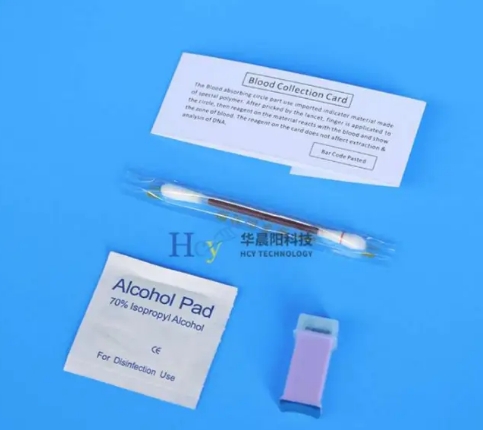What are the technical features and applications of blood collection cards?
The blood collection card is a special card used to collect, store and transport blood samples. The following are its technical features and application introductions:

Technical features
Convenient collection
The design is simple. Usually, only a small amount of blood can be applied or dripped on a specific area of the card to complete the collection, without the need for complex blood collection equipment. For example, in some field surveys or large-scale screening, non-professionals can also operate it easily.
High sample preservation stability
The card has been specially treated and ingredients such as anticoagulants and preservatives have been added. Anticoagulants such as EDTA can prevent blood coagulation and keep the cell components in the blood stable, which is conducive to subsequent testing.
It has a certain resistance to environmental factors. Within a certain temperature and humidity range, it can ensure that DNA, RNA and other bioactive components in blood samples will not be degraded for a long time. It can be stored for several years at room temperature, and it can be stored for longer under suitable low temperature conditions.
Easy to transport and store
Small size and light weight make it easy to transport and store a large number of samples. Multiple collection cards can be placed in a small container to save space. At the same time, it is relatively undemanding for storage conditions and does not need to rely on low-temperature cold chain transportation and storage like traditional blood samples.
Application areas
Medical diagnosis
Disease screening: Widely used in neonatal disease screening, such as collecting heel blood for the detection of congenital hypothyroidism, phenylketonuria and other genetic metabolic diseases. Early detection of diseases by analyzing biochemical indicators or genetic information in the blood.
Infectious disease detection: For epidemiological surveys of some infectious diseases, a large number of blood samples from suspected patients or high-risk groups can be collected. For example, in the monitoring of infectious diseases such as AIDS and hepatitis B, detecting viral antibodies or nucleic acids in the blood helps to understand the epidemic trend and prevention and control effects of the disease.
Forensic identification
Individual identification: In crime scene investigations, blood collection cards can be used to collect blood samples. By analyzing the DNA in the blood and comparing it with the DNA samples of the suspect or victim, the identity can be determined, providing key evidence for case detection.
Parentage identification: Collect blood samples from family members, store them using blood collection cards and send them for inspection, and determine the parent-child relationship by detecting genetic markers in the DNA.
Genetic testing and research
Human genome research: In large-scale population genetic research projects, a large number of individual blood samples need to be collected. Blood collection cards can easily collect and preserve samples to ensure the integrity of genetic information. Researchers can extract DNA from them, analyze the polymorphism of gene sequences, and explore the genetic basis and evolution of human diseases.
Pharmacogenomic research: By collecting patient blood samples, analyze the effects of gene mutations on drug efficacy and adverse reactions. Blood collection cards help collect and preserve these samples, provide a basis for precision medicine, and guide clinical rational drug use.
 A professional supplier of swabs
A professional supplier of swabs
